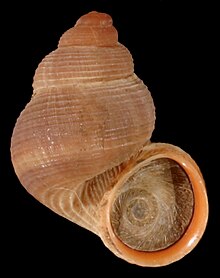The family Pomatiidae is a taxonomic family of small operculate land snails, terrestrial gastropod mollusks that can be found over the warmer parts of the Old World. In the older literature, this family is designated as Pomatiasidae.
| Pomatiidae | |
|---|---|

| |
| Apertural view of a shell and an operculum of the land snail Tudorella sulcata in the family Pomatiidae | |
| Scientific classification | |
| Domain: | Eukaryota |
| Kingdom: | Animalia |
| Phylum: | Mollusca |
| Class: | Gastropoda |
| Subclass: | Caenogastropoda |
| Order: | Littorinimorpha |
| Superfamily: | Littorinoidea |
| Family: | Pomatiidae Newton, 1891 (1828) |
| Genera | |
|
See text | |
| Synonyms | |
| |
This family is a lineage closely related to the Littorinidae (periwinkles) common in coastal habitat. They have adapted to terrestrial life and are thus sometimes called "land winkles".[1]
They are defined by a chalky operculum at the rear end of the body, the shape of their thick shell and their mouth and a characteristic spiral sculpture. The sexes are separate and can sometimes be recognised because the female shell is slightly larger than the male shell.
Taxonomy
editAccording to the Taxonomy of the Gastropoda (Bouchet & Rocroi, 2005), the family Pomatiidae consisted of two subfamilies:[2]
- subfamily Pomatiinae Newton, 1891 (1828) - synonyms: Cyclostomatidae Menke, 1828; Cyclotopsinae Kobelt & Möllendorff, 1898; Ericiidae Wenz, 1915
- subfamily Annulariinae Henderson & Bartsch, 1941, 1920:[3] this subfamily has been raised to the rank of family Annulariidae.
Genera
editGenera within the family Pomatiidae include:
- † Anapomatias Hrubesch, 1965
- † Bauxia Caziot, 1891
- † Bembridgia P. Fischer, 1885
- Bermudezia Torre & Bartsch, 1941
- Chondrothyrella Torre and Bartsch, 1938
- Cinnabarica Neubert, 2009
- Clatripoma Neubert, 2009
- Cyclostoma Lamarck, 1899[2]
- Cyclotopsis Blanford, 1864[2]
- Dioscopoma Neubert, 2009
- † Dissostoma Cossmann, 1888
- Ericia Partiot, 1848:[2] synonym of Pomatias S. Studer, 1789
- Georgia Bourguignat, 1882:[4] synonym of Socotora Pallary, 1925
- Guillainia Crosse, 1884[5]
- Leonia Gray, 1850[6]
- Lithidion Gray, 1850[7]
- † Omanitopsis Harzhauser & Neubauer, 2016
- † Palaeocyclotus P. Fischer, 1885
- Platypoma Neubert, 2009
- Pomatias Studer, 1789 - type genus of the family Pomatiidae[2]
- † Procyclotopsis Wenz, 1924
- Rochebrunia Bourguignat, 1881
- Socotora Pallary, 1925
- Tropidophora Troschel, 1847[8]
- Tudorella Fischer, 1885[9]
References
edit- ^ Journal of Molluscan Studies, GENETIC AND MORPHOLOGICAL VARIATION IN THE LAND WINKLE POMATIAS ELEGANS (MÜLLER) (CAENOGASTROPODA: POMATIASIDAE) Volume 67, Issue 2, pp 145–152 (http://mollus.oxfordjournals.org/content/67/2/145.abstract) Accessed 2014-9-2
- ^ a b c d e Bouchet, Philippe; Rocroi, Jean-Pierre; Frýda, Jiri; Hausdorf, Bernard; Ponder, Winston; Valdés, Ángel & Warén, Anders (2005). "Classification and nomenclator of gastropod families". Malacologia. 47 (1–2). Hackenheim, Germany: ConchBooks: 1–397. ISBN 3-925919-72-4. ISSN 0076-2997.
- ^ Henderson J. B. Jr. & Bartsch P. (1920). "A classification of the American operculate land mollusks of the family Annulariidae". Proceedings of the United States National Museum 58: 49-82. page 54.
- ^ Georgia in GBIF Archived 20 June 2015 at the Wayback Machine
- ^ Guillainia in Bionames.org, accessed 12 december 2015.
- ^ "Genus summary for Leonia". AnimalBase, accessed 28 march 2011.
- ^ Lithidion in GBIF
- ^ KENNETH C. EMBERTON Cryptic, genetically extremely divergent, polytypic, convergent, and polymorphic taxa in Madagascan Tropidophora (Gastropoda: Pomatiasidae) Biological Journal of the Linnean Society - Volume 55, Issue 3, pages 183–208, July 1995
- ^ "Genus summary for Tudorella". AnimalBase, accessed 28 march 2011.
Further reading
edit- Bartsch P. (1946). "The operculate land mollusks of the family Annulariidae of the Island of Hispaniola and the Bahama Archipelago". United States National Museum Bulletin No. 192, 264 pp., 38 pls.
- Pfenninger, M.; Véla, E.; Jesse, R.; Elejalde, M. A.; Liberto, F.; Magnin, F. D. R.; Martínez-Ortí, A. (2010). "Temporal speciation pattern in the western Mediterranean genus Tudorella P. Fischer, 1885 (Gastropoda, Pomatiidae) supports the Tyrrhenian vicariance hypothesis". Molecular Phylogenetics and Evolution. 54 (2): 427–436. doi:10.1016/j.ympev.2009.09.024. PMID 19772926.
- Watters G. T. (2006). The Caribbean Land Snail Family Annulariidae: A revision of the higher taxa and a catalog of the species. 1-557, figs 1-10, map 1-56, Appendix A: 1-3. Backhuys Publishers, Leiden.
External links
edit- Data related to Pomatiidae at Wikispecies
- Media related to Pomatiidae at Wikimedia Commons